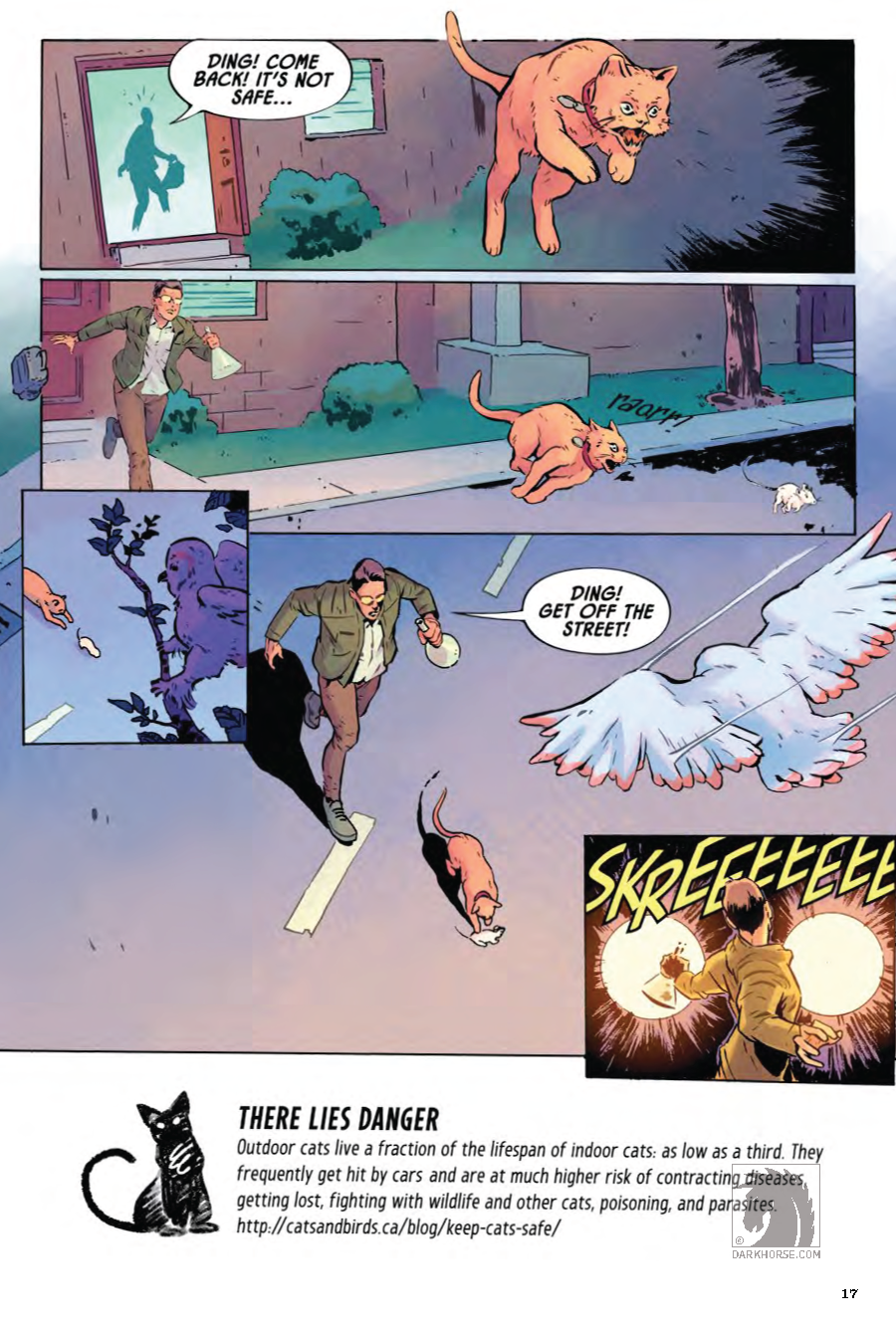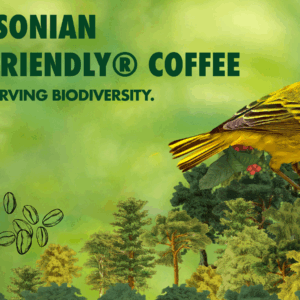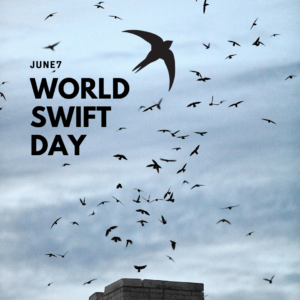Introduction to Angel Catbird
Some find it strange that a person known for her novels and poetry would take to writing comic books, especially comic books called Angel Catbird. Why is a nice literary old lady like me—an award-winning nice literary old lady—a nice literary old lady who should be resting on her laurels in her rocking chair, being dignified and iconic—why is such a nice old lady messing around with flying cat-owl superheroes and nightclubs for cat people, not to mention giant rat men? Strange.
But I myself don’t find it very strange. I was born in 1939, and was thus of a reading age when the war ended and colour comics made a booming comeback. Not only did I read masses of comics in magazine form, I could encounter many of the same characters in the weekend newspapers, which had big spreads of colour comics. Some of the comics were funny—Little Lulu, Li’l Abner, Mickey Mouse, Blondie, and so forth—but some were serious—Steve Canyon, Rip Kirby, and the unfathomable Mary Worth. And some were superheroes: Batman, Captain Marvel, Wonder Woman, Superman, Plastic Man, the Green Lantern, the Human Torch, and their ilk. Some were even aimed at improving young minds: the Classic Comics series had an educational bent.
And some were just weird. In this last category I’d place Mandrake the Magician, Little Orphan Annie—in which nobody had pupils—and Dick Tracy: surrealist masterpieces, all of them, though somewhat disturbing for children. A criminal who could assume anyone’s face, behind which he looked like melting Swiss cheese? It was alarmingly close to Salvador Dalí, and kept me awake nights —as did Salvador Dali, when I came across him years later.
Not only did I read all of these comics, I drew comics of my own. The earliest ones featured two flying rabbit superheroes, somewhat too jolly and fond of somersaults to be considered heavyweights. My older brother had a much larger stable of characters. They had more gravitas: they went in for large-scale warfare, whereas my own superheroes just fooled around with the odd bullet.
Along with the superhero rabbits I drew winged flying cats, many with balloons attached to them. I was obsessed with balloons, as no balloons were available during the war. So I’d seen pictures of them, but never the actual thing. It was similar with the cats: I wasn’t allowed to have one because we were up in the Canadian forests a lot. How would the cat travel? Once there, wouldn’t it run away and be eaten by mink? Very likely. So, for the first part of my life, my cats were flying dream cats.
Time passed, and both the balloons and the cats materialized in my real life. The balloons were a disappointment, liable as they were to burst and deflate; the cats were not. For over fifty years I was a dedicated cat person, with a few gaps here and there when I was a student. My cats were a pleasure, a comfort, and an aid to composition. The only reason I don’t have one now is that I’m afraid of tripping on it. That, and of leaving it an orphan, so to speak.
As the 1940s changed into the 1950s and I became a teenager, the comic that preoccupied me the most was Walt Kelly’s Pogo, which, with its cast of swamp critters combined with its satire of the McCarthy era’s excesses, set a new benchmark: how to be entertainingly serious while also being seriously entertaining. Meanwhile I was continuing to draw, and to design the odd visual object—posters, for the silk-screen poster business I was running on the Ping-Pong table in the late fifties, and book covers, for my own first books, because that was cheaper than paying a pro.
In the seventies I drew a sort-of political strip called Kanadian Kultchur Komix for a magazine called, puzzlingly, This Magazine. I then took to drawing a yearly strip called Book Tour Comix, which I would send to my publishers at Christmas to make them feel guilty. (That didn’t succeed.) It’s no great coincidence that the narrator of my 1972 novel, Surfacing, is an illustrator, and that the narrator of my 1988 novel, Cat’s Eye, is a figurative painter. We all have unlived lives. (Note that none of these narrators has ever been a ballet dancer. I did try ballet, briefly, but it made me dizzy.)
And I continued to read comics, watching the emergence of a new generation of psychologically complex characters with relationship problems (Spider-Man, who begat Wolverine, et cetera). Then came the emergence of graphic novels, with such now-classics as Maus and Persepolis: great- grandchildren of Pogo, whether they knew it or not.
Meanwhile I had become more and more immersed in the world of bird conservation. I now had a burden of guilt from my many years of cat companionship, for my cats had gone in and out of the house, busying themselves with their cat affairs, which included the killing of small animals and birds. These would turn up as gifts, placed thoughtfully either on my pillow instead of a chocolate, or on the front doormat, where I would slip on them. Sometimes it would not even be a whole animal. One of my cats donated only the gizzards.
From this collision between my comic-reading-and-writing self and the bird blood on my hands, Angel Catbird was born. I pondered him for several years, and even did some preliminary sketches. He would be a combination of cat, owl, and human being, and he would thus have an identity conflict—do I save this baby robin, or do I eat it? But he would be able to understand both sides of the question. He would be a walking, flying carnivore’s dilemma.
But I realized that Angel Catbird would have to look better than the flying cats I’d drawn in my childhood—two-dimensional and wooden—and better also than my own later cartoons, which were fairly basic and lumpy. I wanted Angel Catbird to look sexy, like the superhero and noir comics I’d read in the forties. He would have to have muscles.

So I would need a coauthor. But how to find one? This wasn’t a world of which I had much knowledge. Then up on my Twitter feed popped, one day, a possible answer. A person called Hope Nicholson was resurrecting one of the forgotten Canadian superheroes of the wartime 1940s and fundraising it via Kickstarter. Not only that, Hope lived in Toronto.
I put the case for Angel Catbird to her, we got together in a strange Russian- themed pub, and lo and behold, she came onboard and connected me not only with artist Johnnie Christmas, who could draw just the right kinds of muscles and also owl claws, but the publisher, Dark Horse Comics. The Dark Horse editor of the series is Daniel Chabon, who from his picture looks about fifteen. I have never met him, nor have I met Johnnie, nor the excellent colourist Tamra Bonvillain, but I am sure such a meeting will take place in the future.
All of these collaborators have been wonderful. What more could an illustrator manqué such as myself possibly ask for? What fun we have had! At least, I have had fun. Watching Angel Catbird come to life has been hugely engaging. There was, for instance, a long email debate about Angel’s pants. He had to have pants of some kind. Feather pants, or what? And if feathers, what kind of feathers? And should these pants be underneath his human pants, and just sort of emerge? How should they manifest themselves? Questions would be asked, and we needed to have answers.
And what about Cate Leone, the love interest? Pictures of cat eyes flew back and forth through the ether, and at one point I found myself scanning and sending a costume sketch I had done. What would a girl who is also a cat wear while singing in a nightclub act? Boots with fur trim and claws on the toes? Blood-drop earrings?
Such questions occupy my waking hours. What sort of furniture should Count Catula—part bat, part cat, part vampire—have in his castle? Should some of it be upside down, considering the habits of bats? (Count Catula is important in his own right, for bats are in a lot of trouble worldwide.) How to make a white Egyptian vulture look seductive? (You know what they eat, right?) Should Octopuss have a cat face and tentacle hair? Should Cate Leone have a rival for Angel Catbird’s attentions—a part girl, part owl called AtheneOwl? I’m thinking yes. In her human form, does she work at Hooters, or is that a pun too far?
So. Like that.
There is, of course, a science-and-conservation side to this project: it is supplied by Nature Canada, who are not only contributing the statistics that can be found here and there in the book in the banners at the bottoms of the pages, but are also running a #SafeCatSafeBird outreach campaign to urge cat owners not to let their cats range freely. The mortality figures for free- range cats are shockingly high: they get bitten, hit by cars, eaten by foxes, and that’s just the beginning. So, it’s good for cats and good for birds to keep the cats safe, and in conditions in which they can’t contribute to the millions of annual bird deaths attributed to cats. On CatsAndBirds.ca, cat owners can take the pledge, and as the pledges mount up, we can hope that there might be an uptick in the plummeting bird counts that are being recorded in so many places. It may also result in better conditions for stressed forests, since it is the migratory songbirds that weed insect pests out of the trees. Cats aren’t the only factor in the decline of birds, of course—habitat loss, pesticides, and glass windows are all playing a part—but they’re a big factor.
There used to be an elephant who came around to grade schools. He was called Elmer the Safety Elephant, and he gave advice on crossing streets safely and not getting run over. If your school had managed a year without a street accident, Elmer gave you a flag.
In my wildest dreams, Angel Catbird and Cate Leone, and maybe even Count Catula, would go around and give something or other—a flag, a trophy?—to schools that had gathered a certain number of safe-cat pledges. Who knows, maybe it will happen. Before we act, we imagine and wish, and I’m wishing and imagining a result like that. If it does happen, I’ll be the first to climb into my boots with claws on the toes, or maybe sprout some wings, in aid of the cause.
Meanwhile, I hope you enjoy Angel Catbird as much as my partners and I have enjoyed creating it. It’s been a hoot!
Or a meow.
Or both.
— Margaret Atwood, excerpted from Angel CatBird with the permission of the author and Dark Horse Comics



